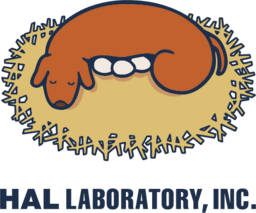HAL Laboratory
HAL Laboratory, Inc. (also known as HAL Labs and previously HALKEN) is a Japanese video game company, formerly a subsidiary of Nintendo prior to 2017. Among the assembly who created HAL Laboratory is Satoru Iwata, the former president of Nintendo of Japan. Among their many creations are the Kirby series and Super Smash Bros. series.
HAL Laboratory are not to be confused with HAL Corporation, a company that split apart from HAL Laboratory after a financial crisis. The result was that HAL Laboratory became a branch of Nintendo and HAL Corporation eventually closed in 2002. HAL Corporation worked on various games such as HAL Wrestling and Eggerland for Windows computers.[1]
Logo
The corporate logo & symbol, Inutamago[2] (Japanese: 犬たまご "Dog Eggs") depicts a dog similar to a dachshund incubating several eggs. According to a 2003 Nintendo Power interview about Kirby Air Ride, producer Masayoshi Tanimura notes that the dog (referred to as the Dream Hatcher) is a fictional creation and that the team do not think of the dog as a dachshund. Tanimura explains that the logo represents deep thought into "incubating completely new ideas that eventually hatch into incredibly fun games".[3] Inutamago has become the symbol of HAL Laboratory since December, 1998.
Video Game Series Produced by HAL
Notable video game series produced by HAL include:
- Eggerland / Adventures of Lolo
- Lololo & Lalala originated from this series.
- Kirby
- Super Smash Bros.
- Super Smash Bros. (Nintendo 64) and Super Smash Bros. Melee were developed by HAL themselves.
- Later titles were developed by other studios.
- BOXBOY!
- Part Time UFO
- Released under HAL's mobile game brand: HAL Egg
HAL was also involved in the creation and/or localization of EarthBound, Sim City 2000, various Pokémon spin-off titles, and others. They have also worked on hardware for Nintendo, including for their most recent console, the Nintendo Switch.
For the full list of HAL's works, see https://www.hallab.co.jp/eng/works/
Staff works for HAL (past and present)
Presidents
The following people are past and present Presidents of HAL Laboratory.[4]
- Mitsuhiro Ikeda (1980/2 - 1984/3)
- Tsuyoshi Ikeda (1984/3 - 1993/3)
- Satoru Iwata (1993/3 - 1999/6)
- Masayoshi Tanimura (1999/6 - 2015/6)
- Satoshi Mitsuhara (2015/6 - 2018/9)
- Shigefumi Kawase (2018/9 - present)
Key Creators
Composers
Trivia
- The name "HAL" is used because each letter is one before those of IBM. This in turn was based off the fictional HAL 9000 computer from 2001: A Space Odyssey.
- Additionally, the sentient computer Star Dream from Kirby: Planet Robobot bears a striking resemblance to the HAL 9000, including its 'cold' single eye, its style of speaking, and its role as a villain.
- There are several references to HAL's other works within the Kirby series. For example, Lololo & Lalala come from the Eggerland series (where they are named Lolo and Lala), and Moto Shotzo is based on the main character of the game Trax. The Kirby Quest mode in Kirby Mass Attack references Arcana, which was Kirby's technical debut as a character; he cameos in the opening sequence. Symbols of HAL often appear in the Stone ability's transformations, such as the Dream Hatcher and HAL's former headquarters, the Kanda building.
- In some Kirby games, hidden HAL Rooms can be found. The Japanese pronunciation of HAL (ハル) can be separated into 8 (は) and 6 (る). Some HAL Rooms can only be entered if the player waits in a certain area for 86 seconds. Furthermore, some games, such as Dedede's Drum Dash Deluxe and Kirby Star Allies, award a high score of 86,555 under special circumstances. In Japanese, 5 is pronounced as "go" (ご), making it "HAL go go go".
- The Halberd, Halcandra, President Haltmann and his Haltmann Works Company may be named after HAL Laboratory.
- In the Japanese version of Kirby Star Allies, the following places and characters may also be references to HAL.
- The fortress, Jambastion, is called ジャマハルダ (Jamahalda). The base, Jambandra, is called マジュハルガロア (Majuhalgaroa). The HAL letters can also be found on the surface of Jambandra.
- The Staff ability enemy, Jammerjab, is called ジャハルビート (Jaharu Beat / Jahal Beat). The weaponless Jammerjab counterpart, Jamaharu Believer, is called ジャハルビリーバ (Jaharu Believer / Jahal Believer).
External links
- Official website
- Official Twitter
- Official YouTube channel (with footage of many video games developed by HAL in the past)
